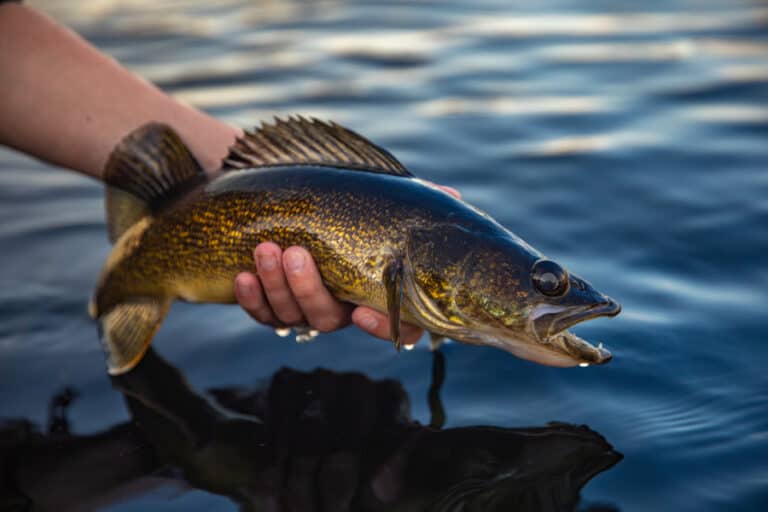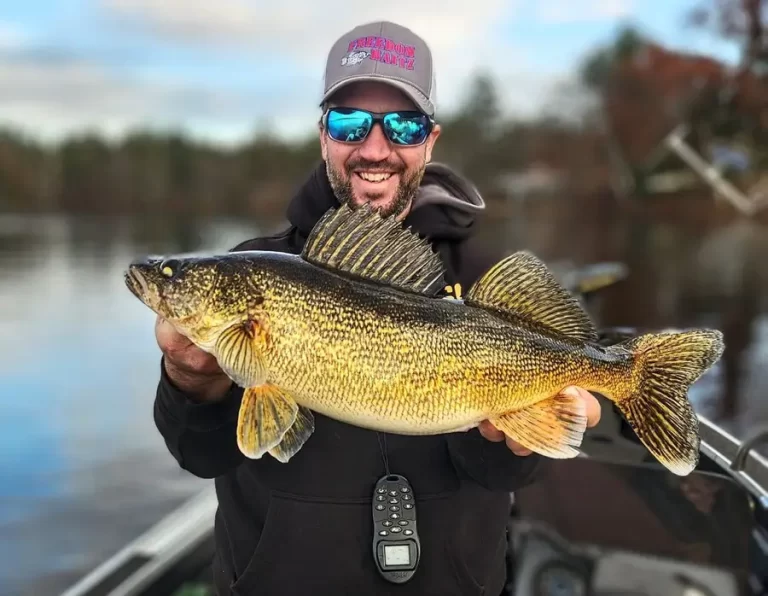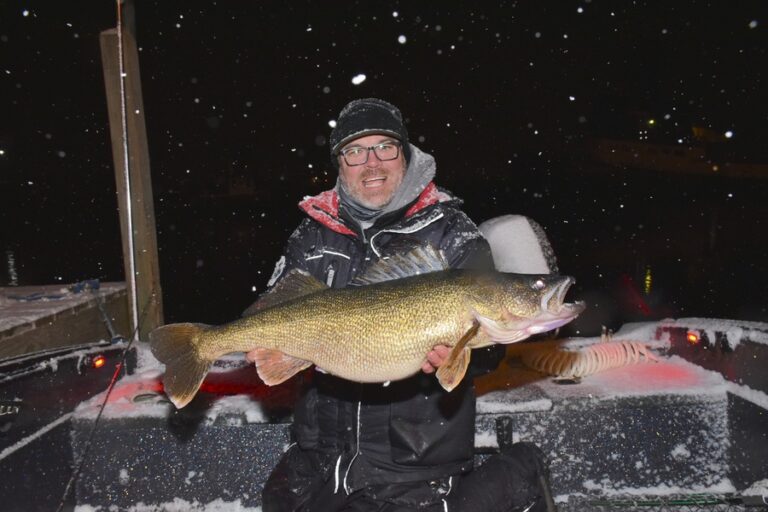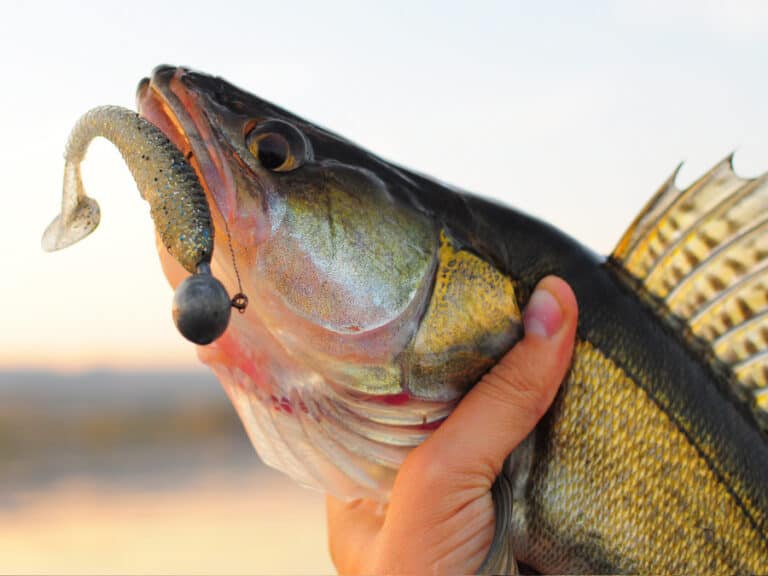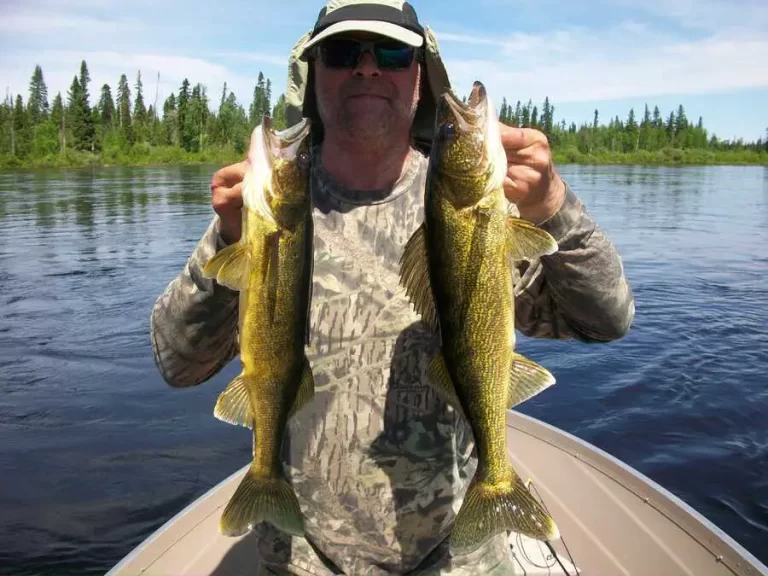How Weather Impacts Walleye Fishing (Day & Night)
Weather can have massive impacts on where walleye move and how they behave. Knowing how they respond to various conditions can help guide your decisions on the water.
Walleye prefer cooler waters on sunny days, approach shallows in rain, and are livelier on cloudy days. Before storms, they’re active, but during storms, they retreat deeper to underwater humps and structure.
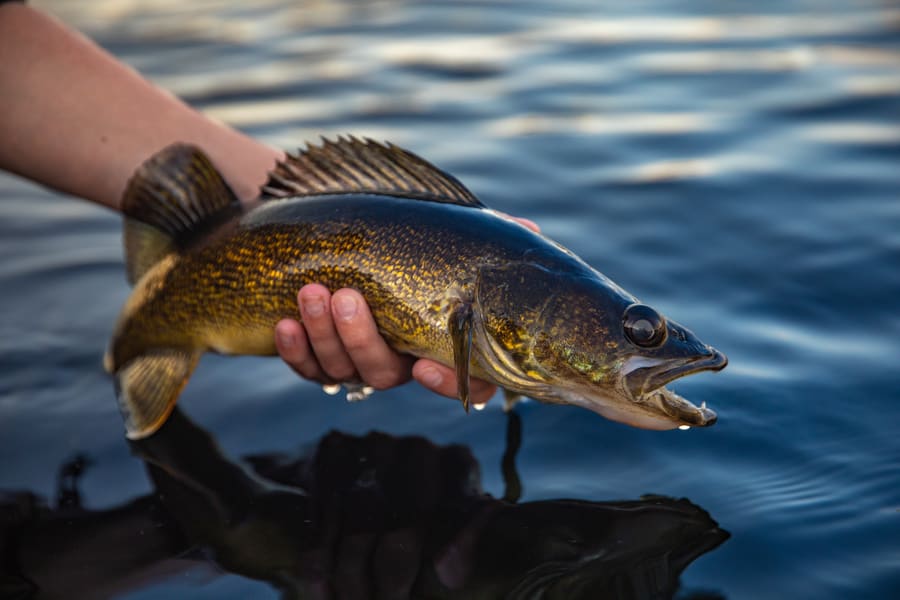
Table of Contents
How Weather Impacts Walleye Fishing
Walleye are highly influenced by changing weather conditions. Let’s look at each major weather condition and see how walleye respond.
| Condition | Walleye Response | Where to Find Them | Depth |
|---|---|---|---|
| Spring – Sunny | Seek shade and cooler waters | Underwater structures; deeper spots | Mid-depth |
| Spring – Rainy | Brave the shallows | Near the shorelines | Shallow |
| Summer – Sunny | Avoid sun; active at night | Deeper waters during the day | Deep |
| Summer – Thunderstorm | Super active before; passive during | Deeper spots during storm | Deep |
| Summer – Cool Evening | Active hunters | Near the shores | Shallow-Mid |
| Fall – General | Active; explore various depths | Mid-depths; surface during fog | Mid-depth |
| Fall – Foggy Morning | Venture to the shallows | Near the shorelines | Shallow |
| Winter – General | Less active; opportunistic feeding | Deeper waters | Deep |
| Winter – Snowy | Slightly more active | Mid-depths | Mid-depth |
| Cloudy Days | Feel safe; more active | Shallow waters | Shallow |
| Windy Days | Follow the food chain | Windward side of a lake | Varies |
Overcast Skies
Cloudy, overcast conditions are great for walleye fishing both day and night. With more limited light penetration, baitfish and walleye rise higher in the water column.
Look for walleye in shallow waters near underwater features like rocks, sunken timber, and reefs. They will be more active hunting than they otherwise would under clear skies.
Bright, Sunny Days
If cloudy skies bring walleye closer to the surface, sunny skies send them down deep. Look for deep features like reefs, ledges, humps, and rock piles down to 40+ feet during the daytime.
Expect walleye to rise mid-depth or into shallow water, chasing rising baitfish at night. Fish at night or first and last light on clear days for the hottest action.
Pre-Storm & Falling Barometric Pressure
Expect walleye to become a lot more active before a storm moves in. The air will feel heavy, but the action will be top-notch. Walleye will be actively hunting food in mid-depth both day and night.
Unlike most other times, walleye will bite readily any time of the day if the storm hasn’t started yet. The hottest fishing you’ll find all day is 1-2 hours before the storm starts.
Post-Storm & Rising Barometric Pressure
This window will make walleye very lethargic and fishing tough. Walleye will retreat to deeper waters. If you decide to fish post-storm, targeting the deeper zones and near significant underwater structures can yield some results, but patience is necessary.
Day or night, it’s generally a more challenging time for fishing. Finesse tactics will be your ticket to catching post-storm fish. Try worm harnesses or even live bait.
Windy Conditions
Wind can stir up sediments, leading to murkier waters. This reduced visibility can make walleye more confident about venturing into shallower zones. Especially on windy days, look for the windward side of the lake where the water is being pushed.
Here, walleye might be hunting smaller fish disoriented by the churning waters. This effect might be less pronounced at night, but the windward edge can still be productive.
Calm & Stable Weather
Stable, calm weather can make walleye more predictable but also a bit more complacent. They’ll likely stick to their regular routines, staying deeper during bright days and coming shallower during dawn, dusk, or night.
Underwater features can be a good place to target during such conditions, especially with a mix of depths. Rock pilings, transitional substrates, and ledges are great spots to start.
Click here to learn how water clarity impacts daytime walleye fishing.
Seasonal Weather Guide
Spring
- General Behavior: Pre-spawn activity makes them hungry and curious.
- Rainy Days: The water turns murky, making walleye brave the shallows even during the day.
- Sunny Days: They prefer shade, so find them near underwater structures or deeper spots.
- Where: Generally shallow waters, but deeper during sunny spells.
- Best Techniques: Light jigs or live minnows work wonders.
- Fishing Verdict: Excellent, especially after a rain when they’re near the surface.
Summer
- General Behavior: They avoid the sun, but they’re active hunters at night.
- Thunderstorms: The pressure drop before a storm can make walleye super active, but they go deep and stay put during the storm.
- Cool Evenings: They venture to the surface and shallows to feed.
- Where: Deep during the day, but closer to shores at night.
- Best Techniques: Deep-diving lures for day; active lures or live baits for night.
- Fishing Verdict: Tricky during sunny days but great on cooler nights.
Fall
- General Behavior: They’re pretty active, exploring different depths.
- Foggy Mornings: These are golden hours. Walleye come to the shallows, making them easier to catch.
- Chilly Nights: They’re a bit less active but still near the surface.
- Where: Mid-depths and sometimes the surface, especially during fog.
- Best Techniques: Spinners or crankbaits, especially those that mimic fall colors.
- Fishing Verdict: Superb. It’s one of the best seasons.
Winter
- General Behavior: They’re less active but will eat if an opportunity arises.
- Snowy Days: The added insulation from snow can make the waters a tad warmer, making walleye a bit more active.
- Clear Ice Days: Sunshine can penetrate clear ice, sending walleye deeper.
- Where: Mostly deeper waters, but they might come up a bit during snowy days.
- Best Techniques: Ice fishing with jigs and live bait like minnows.
- Fishing Verdict: Good for those patient enough and prepared for ice fishing.
Tips for Weather Twists:
- Cloudy Days (any season): Overcast skies are a blessing. Walleye feel safe to roam shallower waters.
- Windy Days: Wind stirs up tiny creatures in the water, which attracts small fish, which in turn attracts walleye. The windward side of a lake is the place to be.
Weather Conditions: How to Catch Walleye
Sunny & Bright
Where to fish: Walleye will retreat to deeper, cooler water. They go deep, near underwater hills or trees when it’s bright out.
Best baits: Use baits that can dive deep like crankbaits or weighted jigs.
Best tactics: Slowly drag your bait near the bottom. This will be a very tempting presentation for more lethargic deeper walleye.
Cloudy or Overcast
Where to fish: Clouds are like sunglasses for walleye. They’ll be closer to the surface, sometimes around rocks or even the deeper edges of submerged weeds.
Best baits: Spinners or spoons that flash a little can grab their attention.
Best tactics: Cast and reel in steadily, making your bait swim naturally. Jerkbait presentations can be great, too. You will want to keep your baits very active during these conditions.
Before a Storm (when the wind starts picking up)
Where to fish: Walleye sense the change and move to mid-depths, often around places where smaller fish might be. Look for reefs and ledges.
Best baits: Live bait like minnows or leeches can be great now. Few things outfish live bait. Just prepare yourself for a few deep hooked fish.
Best tactics: Keep the bait lively, but not too fast. Walleye will be more eager to bite, thinking a storm’s coming.
After the Storm
Where to fish: Walleye might be feeling lazy now. They’re deeper, resting near solid structures. Humps, deep reefs, rock pilings, and other deep formations.
Best baits: Worm harnesses or soft plastic baits that move slowly and look easy to catch.
Best tactics: Patience is key. Give walleye time to decide if they want the bait. The bites will be slow and lazy. Use braid mainline to a long fluorocarbon leader to feel even the lightest bites.

Windy Days
Where to fish: The windy side of the lake. The wind pushes small fish (food for walleye) towards the shore, and walleye follow. Don’t go any shallower than 8 feet deep though.
Best baits: Whatever looks like the small fish in that lake. It could be small crankbaits or even live minnows. Jerkbaits can also be good as they mimic injured erratic baitfish.
Best tactics: Cast into the wind and reel back with the current. It makes the bait look real and lost in the wind.
Calm and Quiet
Where to fish: Explore various spots. Walleye could be anywhere, from deep waters to mid-depths. This is normally the toughest time to locate walleye. I recommend trolling to find these scattered fish.
Best baits: A mix of live baits and artificial lures. Sometimes a simple worm rig or a flashy spinner can work wonders.
Best tactics: Try different speeds and depths. See where the walleye are most active. Trolling is the way to go in my opinion.
Tips for Weather-based Walleye Fishing
- Temperature Tracker: Let your electronics find cooler water pockets in summer. Walleye will likely gather there.
- Barometric Watch: Fish aggressively before a storm when the barometer is falling. Walleye are more active and hungry then.
- Overcast Mastery: Utilize brighter or reflective lures on cloudy days to take advantage of the reduced sunlight penetrating the water.
- Dawn and Dusk: On clear days, target walleye during twilight hours when they come to shallower areas to feed.
- Windward Edge: On windy days, fish the lake’s windward side. The wind pushes baitfish, and walleye follow them.
- Stealth Mode: Walleye are cautious. Use a silent approach, especially in calm waters. Turn off electronics and tread lightly.
- Moonlit Nights: Walleye feed more on nights with a brighter moon. Nights with a full moon are going to be your best bet.
- Post-Storm Patience: After a storm, use slower-moving baits in deeper water. Walleye are less active but can still be enticed.
- Current Zones: Fish in areas with slight current breaks in rivers or streams. Walleye often rest and hunt there. This is especially true when the river is flooded. Find calmer water and you’ll find some fish.
- Sound Tactics: Use rattling lures or noise-making tactics in murky waters after heavy rains. The sound can attract walleyes more limited visually by muddier water.
- Contrasting Lures: A lure contrasting against the background can catch a walleye’s eye in clear water. Think dark lures in light conditions and vice versa.
- Bottom Bouncing: During stable, calm conditions, use a bottom-bouncer rig to mimic creatures that walleye feed on near the lake bed.
- Cover Areas: On overcast days, walleye are more likely to be near underwater structures. Cast close to rocks, fallen trees, or man-made structures.
- Temperature Shifts: Look for areas where warmer shallow waters meet cooler deep zones in spring and fall. Walleye often transition between these areas.
- Natural Baits: During post-storm calm, natural baits like live minnows or worms can be more effective than artificial ones.
- Surface Play: Try topwater lures in shallower regions on cool, overcast days. Walleye might be hunting just below the surface.
- Trolling Tactics: On days with mixed weather, trolling at varying depths can help locate where walleye are active. This will be your best strategy to cover various depths until you locate fish. I like this method, especially for bigger water.
Conclusion
Weather greatly affects walleye behavior and location. On sunny days, walleye stay in deep waters, but they come closer to the surface during cloudy conditions, especially near underwater features. Before a storm, they become highly active in mid-depths but go deeper and become less active once the storm hits.
Windy conditions push walleye to shallower zones on the windward side of the lake, following their prey. For successful fishing, it’s essential to understand these patterns and adjust techniques accordingly.

